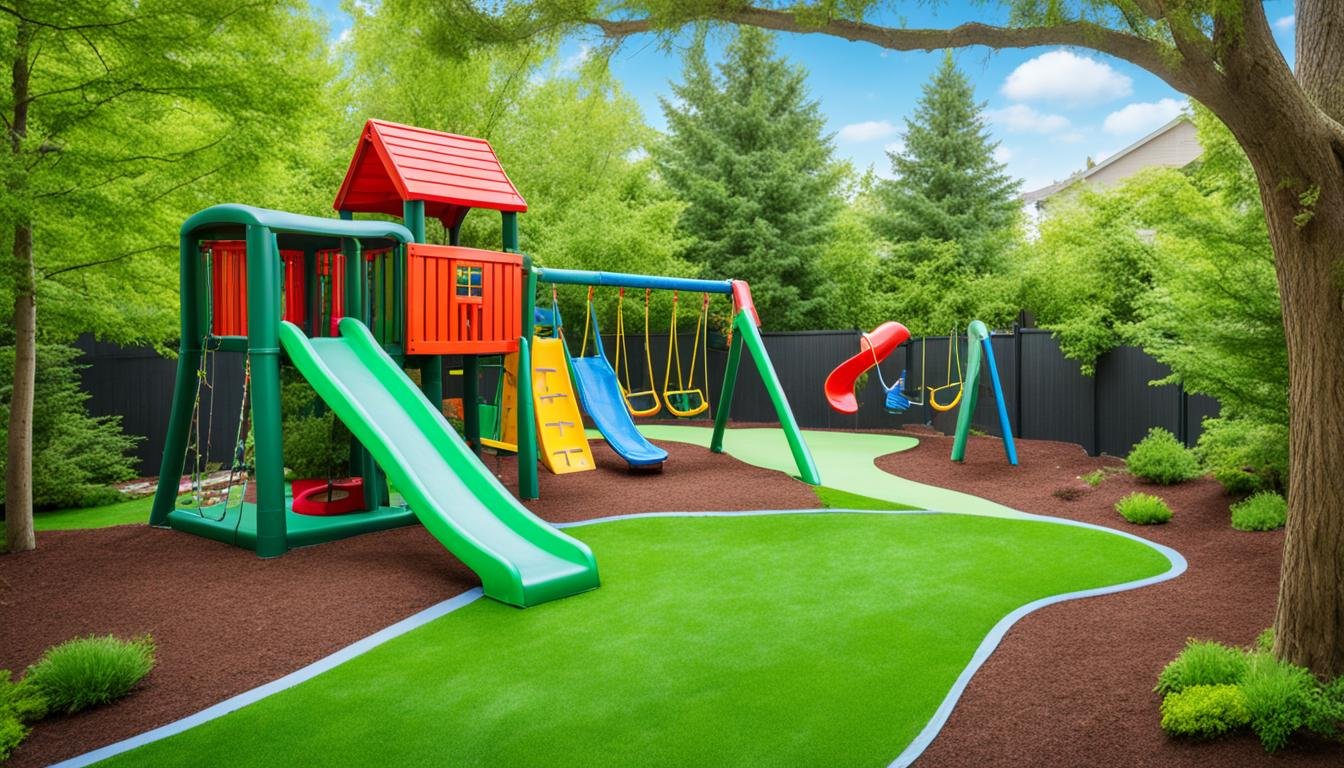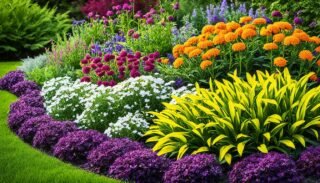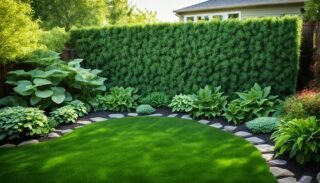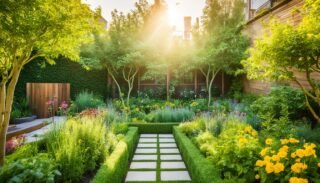Table of Contents
- Why Create a Backyard Play Area for Your Kids
- Planning Your Backyard Play Space
- Safety Considerations for Backyard Play Areas
- Budget-Friendly DIY Play Area Ideas
- Backyard Play Areas for Kids: Popular Equipment Options
- Incorporating Nature into Your Play Area
- Creating Themed Play Zones
- Maximizing Small Backyard Spaces
- Maintaining Your Backyard Play Area
- Adapting Play Areas for Different Age Groups
- FAQ
- Why is it important to create a backyard play area for kids?
- How do I plan an effective backyard play space?
- What safety considerations should I keep in mind?
- Can I create a backyard play area on a budget?
- What are some popular equipment options for backyard play areas?
- How can I incorporate nature into the play area?
- Can I create themed play zones in the backyard?
- How can I maximize a small backyard space for a play area?
- What maintenance is required for a backyard play area?
- How can I adapt the play area as my children grow?
Ever thought about making your backyard a magical place for your kids? I’ve been on a quest to create the perfect spot for them. I’m excited to share what I’ve learned with you.
Outdoor play spaces are more than just fun. They’re key to your child’s growth. They boost physical activity and help spark creativity. A well-designed backyard can change the game for kids.
This guide will show you how to turn your backyard into a kids’ paradise. It doesn’t matter if you have a big lawn or a small corner. I’ve got ideas that will make your outdoor area the envy of everyone.
Key Takeaways
- Backyard play areas promote physical activity and imagination
- Safety is paramount when designing outdoor play spaces
- DIY ideas can create budget-friendly play areas
- Incorporating nature enhances the play experience
- Regular maintenance ensures long-lasting enjoyment
- Play areas can be adapted for different age groups
Why Create a Backyard Play Area for Your Kids
Creating a backyard play area for kids is a great choice for parents. It encourages kids to spend more time outside. This leads to many benefits for their development.
Promoting Outdoor Activities
A well-designed backyard play area pulls kids outside. It keeps them away from screens and into the fresh air. This helps them develop a love for being active that lasts.
I’ve seen how a simple swing set or sandbox can keep kids busy for hours. It’s amazing to watch them have so much fun.
Enhancing Physical Development
Physical activity is key for kids’ growth and health. A backyard play area offers endless ways for them to move. Activities like climbing, swinging, and running make muscles stronger.
These activities help with coordination and balance. They set the stage for a healthy, active life.
Fostering Creativity and Imagination
Outdoor play spaces are great for sparking creativity and imagination. A simple playhouse can turn into a castle, spaceship, or secret hideout. This kind of play is vital for thinking, solving problems, and social skills.
Creating a backyard play area gives kids a safe space for outdoor fun. It’s an investment in their health, happiness, and growth. This space offers many benefits that last a lifetime.
Planning Your Backyard Play Space
Starting to plan a fun and safe backyard play area is key. I first look at the space I have in my yard. This lets me see what play elements I can add and where they should go. I also think about the natural features like trees or slopes in my outdoor space.
Then, I consider my kids’ ages and what they like. This helps me decide on the play area layout. For little ones, I might choose simple play structures and sensory activities. Older kids might prefer more challenging equipment. I aim to make a space that can change as my kids grow.
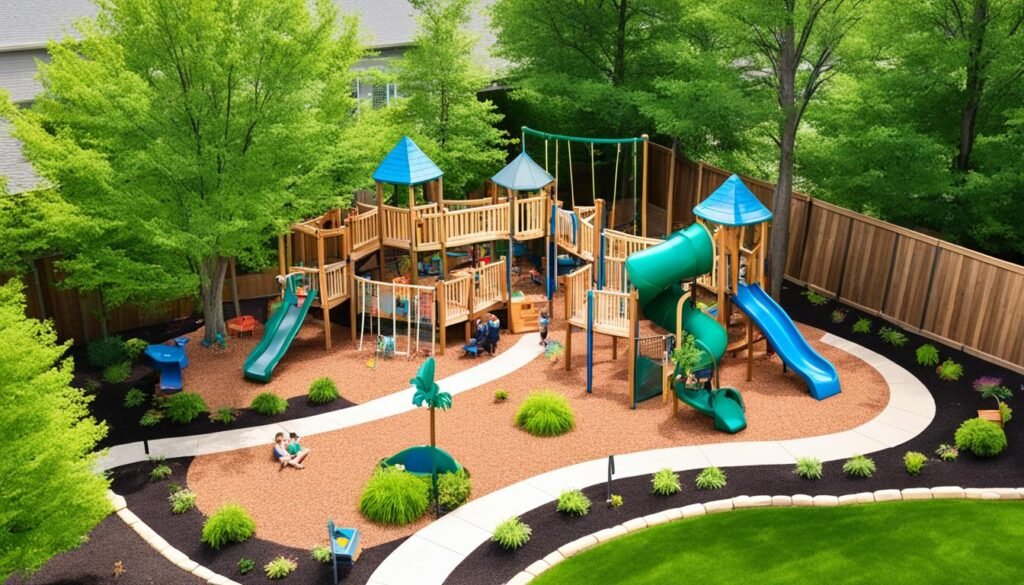
Planning the outdoor space means balancing different play areas. I want to have spots for active play, quiet time, and creativity. Here’s a simple plan I follow:
- Active play zone: swings, slides, climbing structures
- Quiet zone: reading nook, picnic area
- Creative zone: art station, sandbox
Safety is crucial in my backyard design. I make sure there’s enough room between play equipment and remove any dangers. I also use soft ground cover under play structures. With careful planning, I make a safe and fun place for my kids to play outside.
Safety Considerations for Backyard Play Areas
I always put playground safety first when designing backyard play areas for kids. It’s important to make a space where kids can have fun and stay safe. Let’s look at some key safety tips to remember.
Choosing Age-Appropriate Equipment
It’s key to pick safe play equipment for kids. I choose play structures that fit the age and skills of the kids. For toddlers, I go for low platforms and simple slides. Older kids can enjoy more challenging things like monkey bars or climbing walls.
Ensuring Proper Ground Surfacing
Fall protection is very important in any play area. I always put in shock-absorbing surfaces under and around play equipment. Some good choices include:
- Rubber mulch
- Wood chips
- Pea gravel
- Synthetic turf with padding
These materials help soften falls and lower the chance of serious injuries.
Implementing Safety Measures
To make playgrounds safer, I take several steps:
- Regular equipment checks
- Proper spacing between play areas
- Soft edges and rounded corners
- Secure anchoring of all equipment
By following these tips, I make a safe and fun backyard play area. Kids can explore and have fun without worry.
Budget-Friendly DIY Play Area Ideas
I love making fun spaces for kids without spending a lot. Affordable playground ideas can turn your backyard into a thrilling play area. Let’s check out some creative DIY outdoor toys and homemade play equipment.

Using everyday items in new ways is a smart move. Old tires can be colorful planters or part of a fun obstacle course. Wooden pallets are great for a simple treehouse or fort. These DIY projects save money and let you customize for your space and kids’ interests.
Here are some easy DIY play area elements:
- Sandbox using a large plastic container
- Balance beam from a sturdy wooden plank
- Mud kitchen with old pots and pans
- Obstacle course using hula hoops and pool noodles
Remember, safety is key with homemade play equipment. Always smooth out rough edges, secure loose parts, and choose non-toxic materials. With creativity and effort, you can make a fun play area your kids will adore, all while sticking to your budget.
Backyard Play Areas for Kids: Popular Equipment Options
I love making outdoor spaces fun for kids. The right outdoor play equipment can really boost their backyard fun. Let’s look at some top choices that turn any yard into a playground.
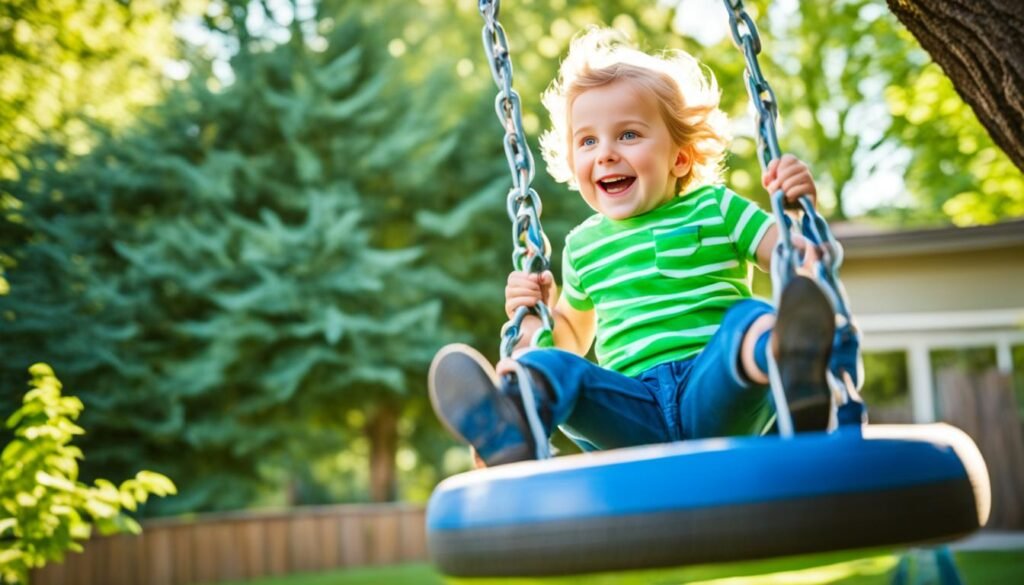
Swing Sets and Playsets
Swing sets are timeless favorites. Kids adore the thrill of flying high. Today’s playsets come with swings, slides, climbing walls, and even mini clubhouses. These all-in-one sets offer lots of fun in a small area.
Sandboxes and Water Tables
Sandboxes and water tables are great for little ones. They spark creativity and sensory play. Kids can build sandcastles, make mini rivers, or play pretend for hours. These simple toys keep them entertained for a long time.
Climbing Structures and Obstacle Courses
Climbing structures boost strength, balance, and coordination. You can find everything from simple dome climbers to big jungle gyms. Obstacle courses are also thrilling. They test kids physically and mentally, building their confidence as they learn new skills.
When picking outdoor play equipment, think about your space, budget, and kids’ ages. With the right mix of playground gear, you can make a backyard paradise. It will keep kids active and happy for many years.
Incorporating Nature into Your Play Area
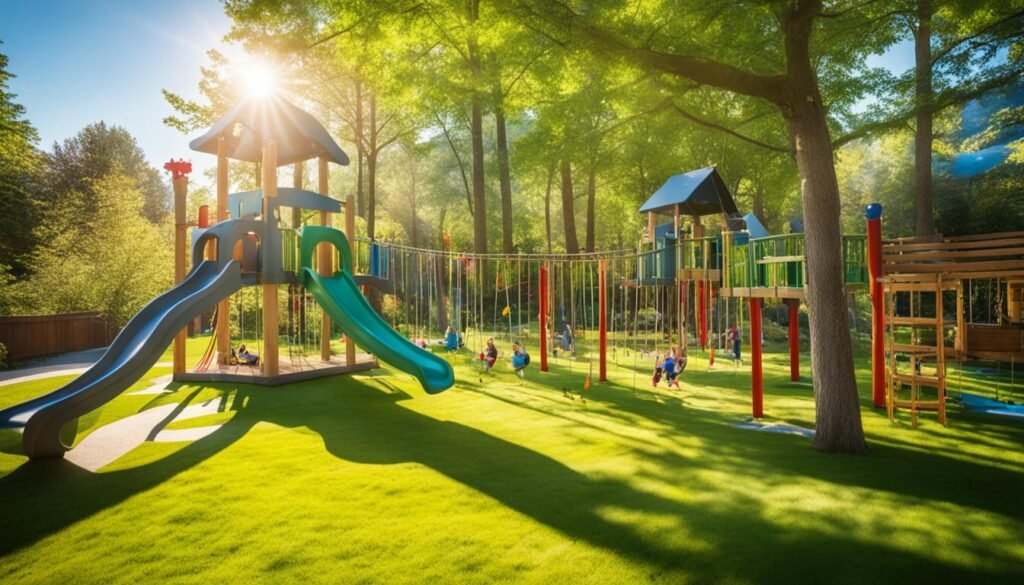
I love nature play and think it’s key for kids’ growth. Making an eco-friendly playground at home is a smart move for outdoor learning. Let’s look at ways to add nature to your play space.
Begin by adding natural stuff to your playground. Use logs as balance beams or stepping stones. Make a rock garden for kids to climb and explore. These easy steps can turn your area into a fun nature play spot.
Plant different native plants and trees. This makes your yard look better and brings in wildlife like butterflies and birds. It’s a great chance for kids to learn about local nature right at home.
- Set up a small vegetable garden
- Create a butterfly garden with nectar-rich flowers
- Install a bird feeder or birdbath
Think about adding a water feature like a small pond or stream. It’s a cool way to add sensory play and teach kids about water worlds. Just make sure it’s safe and watched over for little ones.
With these natural elements, you’re doing more than just making a play area. You’re building an outdoor learning spot that encourages curiosity, respect for nature, and a love for the outdoors. It’s great for kids and the planet!
Creating Themed Play Zones
I love designing themed playgrounds for kids. These spaces spark imagination and make outdoor time exciting. Let’s look at some fun ideas for themed zones in your backyard.
Adventure and Exploration Zone
Make a part of your yard a mini adventure park. Add a small climbing wall, a rope bridge between trees, or a treasure hunt area. Kids can pretend to be explorers or archaeologists, digging for hidden treasures.
Arts and Crafts Corner
Set aside a space for art. Put in a weatherproof easel or chalkboard wall. Have a table with art supplies. This area lets kids be creative and enjoy art outside.
Sensory Play Area
Create a space full of different textures and materials. Include a sand table, water play area, and musical instruments from recycled stuff. These stations help kids learn and have fun.
Adding these themed zones turns your backyard into a fun playground. These spaces offer many experiences, keeping kids active and engaged. Remember to change the zones as your kids grow for fun, age-right activities.
Maximizing Small Backyard Spaces
Many families struggle to make their small yards fun for kids. But don’t worry, there are ways to make the most of your space. With creativity, you can design engaging areas that your kids will adore.
A vertical climbing wall is a great choice for saving space. It offers lots of fun and exercise without taking up much room. Another smart idea is a fold-down art easel on a fence or wall. It’s perfect for outdoor creativity without using up too much space.
For little ones, think about a small sensory table that can be a sandbox or water play area. These tables are great for small spaces and can be moved easily. Look for furniture that does more than one thing, like benches with hidden storage or a picnic table that turns into a stage.
- Utilize vertical space with hanging planters or a garden wall
- Install a retractable canopy for shade and rain protection
- Use modular play equipment that can be rearranged or expanded
The aim is to make a space that’s both fun and functional, growing with your kids. With these ideas, even a tiny backyard can become a thrilling place for your kids.
Maintaining Your Backyard Play Area
Keeping a backyard play area in top shape can be tough. That’s why I’ve shared some tips for playground maintenance and equipment care.
Regular Inspections and Repairs
I check my kids’ play equipment every week. I look for loose bolts, splintered wood, or rusted metal. Fixing small issues early prevents big problems later. If I find any problems, I fix them right away to keep the play area safe.
Seasonal Maintenance Tips
Each season has its own maintenance needs. In spring, I clean off winter grime. Summer means tightening bolts that have loosened from heavy use. Fall is the time to seal wooden structures. Winter? I cover or store smaller items to protect them from harsh weather.
Cleaning and Sanitizing Play Equipment
Cleaning outdoor toys is key for health and longevity. I use mild soap and water for most surfaces. For tough jobs, a diluted bleach solution works great. I always rinse thoroughly and let equipment dry before use. Regular cleaning keeps germs away and extends the life of play items.
- Wipe down surfaces weekly
- Deep clean monthly
- Sanitize high-touch areas often
By following these simple steps, our backyard play area stays safe, clean, and fun for years.
Adapting Play Areas for Different Age Groups
Creating versatile play areas is crucial for keeping kids engaged as they grow. By focusing on age-appropriate play equipment, I make sure my backyard stays fun and safe for years. Multi-age playgrounds are perfect for families with kids of different ages.
For toddlers, I set up low-to-the-ground structures and sensory play elements. As kids get older, I add more challenging equipment like climbing walls or monkey bars. This way, the play area changes as the kids grow, meeting their new skills and interests.
To use my space well, I choose modular play systems that can change or grow over time. These let me add or remove parts as needed, keeping the play area exciting. By planning and adapting the space, I create a backyard that kids of all ages will enjoy exploring and playing in.

